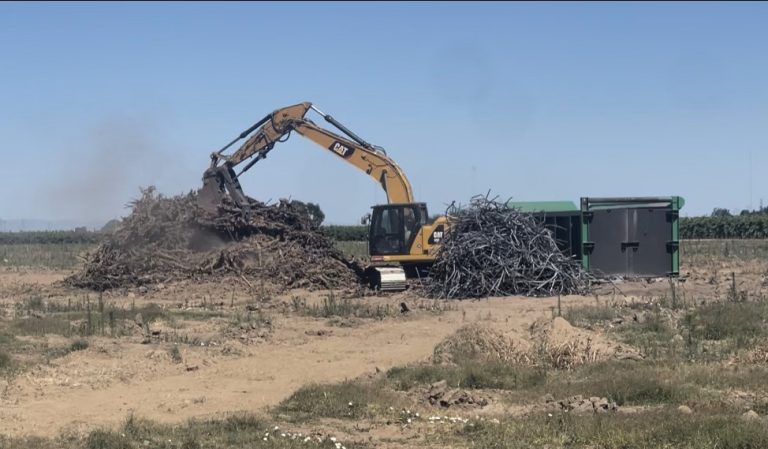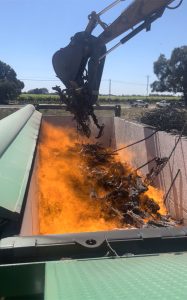
In the next two years, California’s Central Valley will experience a transformational change in agriculture: the end of open agricultural burning. It is likely that other regional air districts around the state will adopt a similar prohibition of open agricultural burning in the years to follow.
Under SB 703 (Florez) Chapter 481, Statutes of 2003, open burning for agricultural crops is phased out under a prescribed schedule. This schedule will result in the near-complete prohibition of agricultural open burning in the Central Valley beginning Jan. 1, 2025.
In preparing for this, the California Association of Winegrape Growers (CAWG) worked with other agricultural industry associations in 2021 and successfully advocated in the State Legislature for nearly $180 million in funding for the San Joaquin Valley Air Pollution Control District. This one-time influx of money in part provides funding for the District’s Alternatives to Agricultural Open Burning Incentive Program. This stipend program is intended to help growers pay the high costs of alternatives to open agricultural burns during the phaseout.
For decades, the disposal of old orchards and vineyards has commonly involved burning. For vineyards, the materials used in trellising, such as end posts, t-posts and wire have created unique challenges in how to dispose of vines when removed. That is why up and down the Central Valley, you may see piles of pulled vineyards left sitting waiting to be disposed of.
In 2003, opponents to SB 703 warned of the very situation in which we now find ourselves. The analysis by the Assembly Committee on Natural Resources, dated June 30, 2003, stated, the following:
“Bill opponents state that while the agricultural community is willing to pursue means to reduce or eliminate burning when feasible, it is important that alternatives to burning be established BEFORE the prohibition is enacted.”
Unfortunately, that advice was not heeded.

Alternatives
To address this situation, CAWG will be advocating in the legislature in 2024 to obtain additional funding to develop viable alternatives for disposing of vineyards. However, this will be difficult as almost every alternative comes with unique challenges. The alternatives and associated challenges are outlined as follows:
Chipping and Mulching: This alternative involves the grower to either hire a company to chip or mulch the piles of vines on-site or ship those piles to a facility equipped for chipping and mulching.
There are three specific challenges with this alternative:
Economics. Most of the machines used to chip, mulch or grind vines don’t work well with metals. This means all metal would need to be removed first, which can be a very costly endeavor. Additionally, if the vines are being shipped to a facility, shipping costs can also be expensive.
Disease. When old vines are removed due to disease, chipping and mulching is not a viable option as this would potentially result in putting disease back into the soil or spreading the disease to nearby vineyards. The federal Tree Assistance Program (TAP) provides financial assistance to eligible growers to replant. A condition of the TAP program is the diseased vine cannot be reincorporated into the soil and best practices prioritize burning.
Market Demand. Increased forest management (preventing fires) and the recent prohibition of putting food and other organic waste into landfills has resulted in a substantial increase in the supply of compost, mulch, wood chips and other similar groundcover. This means if a grower decides to dispose of old vines through chipping and mulching, no one may be waiting to buy that material. So, what is the grower to do with that material? While there is a beneficial use of this material in a new vineyard, there is only so much a grower can use.
Air Curtain Burners, also called FireBoxes: These act as an air pollution control device by reducing the particulate matter, smoke or black carbon created by burning wood waste. This alternative to traditional open burning mitigates the amount of smoke released from open agricultural burning. This also creates a valuable byproduct that can be tilled into the soil. The downside is that while some growers can afford this equipment, most cannot. Additionally, there is limited availability of these burners.
Low-Smoke Ag Burning: This is an important option (for 2024 only) in dealing with vineyard management waste. Low-smoke agricultural burning, when using best practices, takes into consideration concerns of public health as well as climate change. The challenge here is how long a grower needs to wait for approval of a burn day. Depending on several meteorological factors and how many people want to burn in that area, a grower with a permit to burn could wait for several months to get approval, and that grower is not guaranteed to be able to burn their full permitted amount in one day.
Biochar: This is one of the smartest alternatives that also offers incredible benefits. One ton of biochar is equivalent to three tons of CO2 sequestered. By turning old vineyards into biochar, carbon remains trapped in its solid form, thus creating a carbon-negative cycle. However, few Pyrolysers (an oven that creates biochar through pyrolysis) exist in the Central Valley. Additionally, there are economic challenges in shipping.
Biomass: Vines can be used as alternative fuels within energy conversion chains, driving renewable energy exploration as an alternative to traditional agricultural biomass burning. The ability to convert grapevine biomass residues into energy is potentially a valuable alternative to explore in the future. However, there would need to be an expansion of markets and availability. Unfortunately, policymakers in Sacramento currently do not see biomass as an effective tool in fighting climate change and protecting clean air.
CAWG has created a hotline for its members who find they have reached a dead end in getting approval to burn. It is recommended that CAWG members diligently go through the steps provided on cawg.org’s Ag Burn Hotline Webpage (under the Resource Tab) before completing the form for CAWG’s assistance.











